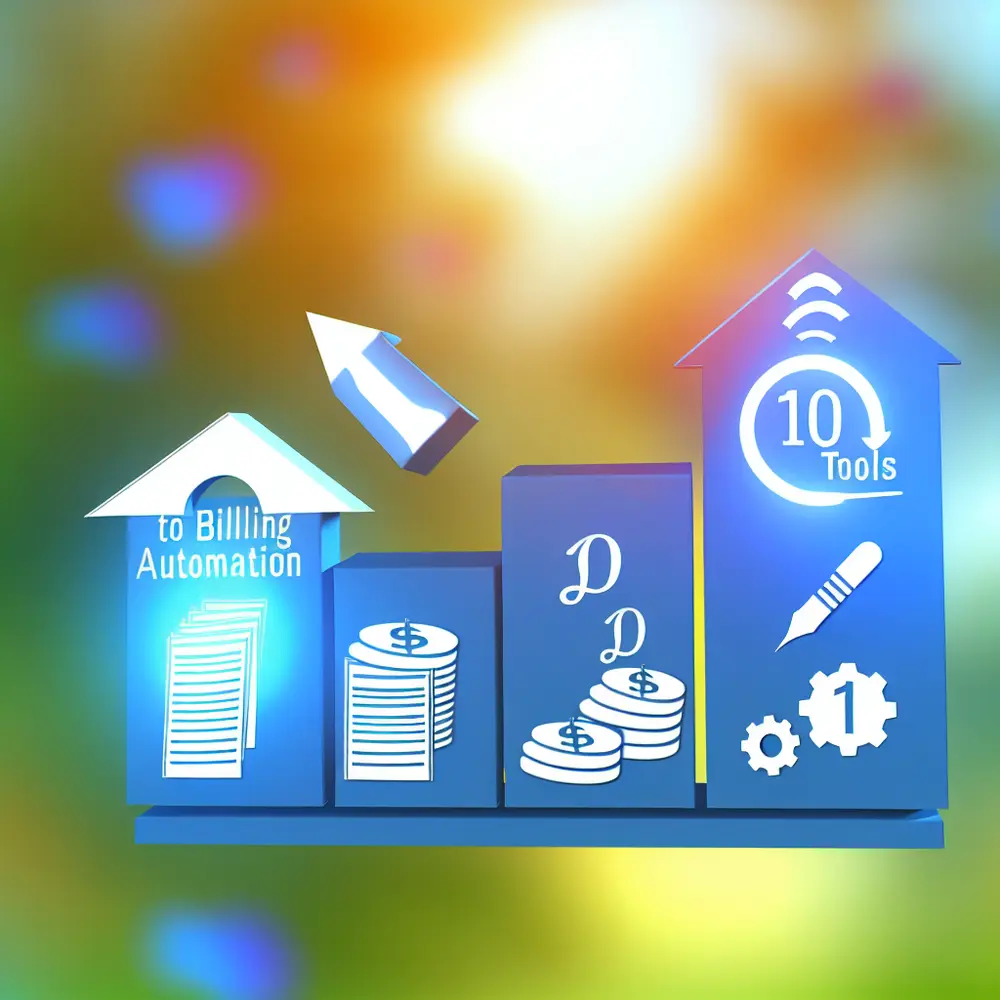In today’s fast-paced business landscape, efficiency has become a critical goal that organizations strive to achieve. As such, the trend of billing automation is sweeping across industries, captivating the attention of businesses of all sizes. The idea of automating invoicing and payment processes not only promises enhanced productivity but also minimizes human errors and administrative burdens that often plague traditional billing methods.
Billing automation offers myriad advantages, including accelerated cash flow and seamless operational processes. Imagine a scenario where your team can redirect their efforts from mundane billing tasks to strategic initiatives that drive growth. As you delve into the details of billing automation, you will uncover how these tools facilitate a smoother and more efficient way of managing finances, creating a win-win situation for both businesses and customers alike.
Curious how to navigate the world of billing automation? This comprehensive guide not only outlines the benefits but also walks you through the necessary steps to implement effective solutions in your organization. Whether you are a developer, IT professional, or a business owner, understanding billing automation will position you for success in modernizing financial operations. Let’s explore how you can harness this powerful tool for your company’s advantage.
Understanding Billing Automation
Billing automation streamlines the invoicing and payment processes, significantly enhancing efficiency for businesses of all sizes. By minimizing manual effort, billing automation tools help reduce errors, save time, and accelerate cash flow. This process involves automating repetitive tasks such as invoice generation, payment reminders, and reconciliation, which not only frees up valuable resources but also allows companies to focus on strategic growth initiatives rather than administrative tasks.
Implementing billing automation starts with identifying the right software tools that fit specific business needs. A myriad of solutions is available, offering various features such as customizable invoicing templates, automated payment processing, and integration capabilities with other business systems. This ensures a seamless flow of information, from sales to accounting, promoting greater accuracy and transparency throughout financial operations.
Moreover, billing automation contributes to enhanced customer experience. Businesses can provide clients with timely and accurate invoices, reducing frustrating discrepancies that might otherwise strain relationships. With the capability to send automated reminders before due dates, companies can also decrease late payments, thereby improving cash flow and decreasing the financial strain on operations.
To embark on the journey of billing automation, it is crucial to understand not only the potential benefits but also the steps involved in selecting and implementing the right tools. This comprehensive guide will take you through a step-by-step process, enabling you to navigate the world of billing automation effectively, ensuring you select the software that best aligns with your business objectives and operational requirements. Embracing billing automation is not just a trend; it is a strategic move towards modernization and efficiency in business operations.
Benefits of Billing Automation
Billing automation offers a plethora of benefits for businesses, streamlining processes and improving overall efficiency. One of the most significant advantages is the reduction of manual errors. By automating billing processes, organizations can minimize human intervention in data entry and calculations. This not only speeds up the billing cycle but also enhances accuracy, ensuring that invoices are generated without discrepancies. Consequently, businesses can maintain a professional image and foster trust with their clients, as accurate billing contributes to better customer relationships.
Another crucial benefit of billing automation is the time savings it provides. By utilizing software tools designed for billing automation, companies can free their teams from tedious, repetitive tasks. The time that was once spent generating invoices, tracking payments, and following up on overdue accounts can now be redirected toward strategic initiatives and business development. This shift enables organizations to focus on growth-oriented activities instead of getting bogged down by administrative duties.
Cost reduction is also a prominent advantage of implementing billing automation. Traditional billing processes can involve extensive labor costs, printing, postage, and associated administrative expenses. Automation significantly cuts these costs by digitizing and streamlining the entire process. Additionally, quicker payment cycles resulting from automated invoicing and reminders can significantly enhance cash flow, making it easier for businesses to allocate funds toward operational growth and investment opportunities.
Lastly, billing automation provides valuable insights and analytics that can drive business decisions. With automated systems in place, companies gain access to real-time data regarding billing trends, customer payment behavior, and overall financial health. This information allows organizations to make more informed decisions concerning pricing strategies, credit terms, and customer relationship management. Overall, implementing billing automation is not merely a technological upgrade; it is a strategic move that can enhance efficiency, accuracy, and profitability, positioning businesses for long-term success.
Key Features to Look for in Billing Automation Tools
When evaluating billing automation tools, several key features stand out as essential for both operational efficiency and user satisfaction. First and foremost, the solution should offer robust integration capabilities with existing accounting, ERP, and CRM systems. This seamless integration is vital for maintaining data consistency across platforms and ensuring that billing processes align with business workflows. Automation tools that can synchronize with multiple systems help eliminate manual entry errors, streamline operations, and provide a unified view of financial data.
Another critical feature is customizable billing templates. Companies vary significantly in their invoicing needs, from subscription models to one-time service charges. The ability to easily create and modify templates ensures that invoices reflect branding and meet specific regulatory requirements. A tool with a user-friendly interface that allows businesses to design not only professional-looking invoices but also automated reminders for overdue payments can significantly enhance cash flow management. This customization can lead to improved customer satisfaction as well.
Furthermore, advanced reporting and analytics capabilities are crucial. Billing automation tools should provide insights into revenue trends, payment cycles, and customer behavior, enabling organizations to make informed business decisions. Analytics can help identify patterns and anomalies in billing processes, allowing for proactive rather than reactive management of financial operations. Teams equipped with these insights can optimize pricing strategies, forecast revenue more accurately, and ultimately drive better business outcomes.
Finally, security and compliance features cannot be overlooked. As billing involves sensitive financial data, it’s imperative that automation tools employ strong encryption and adhere to relevant compliance standards, such as PCI DSS. Companies should prioritize tools that offer security measures like two-factor authentication and audit trails to safeguard against fraud and data breaches. By finding a billing automation solution with these key features, businesses can enhance their efficiency, accuracy, and overall financial health in an increasingly automated landscape.
Top Billing Automation Tools
Billing automation tools have revolutionized the way businesses manage invoicing and payments, providing significant efficiency gains and accuracy when compared to manual processes. In this overview, we present ten of the top billing automation tools currently available, allowing companies to streamline their billing processes and enhance overall cash flow management.
First on the list is Chargebee, a powerful subscription management platform that automates billing, invoicing, and revenue recognition. Chargebee integrates seamlessly with various payment gateways and supports multiple billing models, making it ideal for SaaS companies and businesses with recurring revenue. By offering detailed analytics and compliance features, it helps businesses maintain a healthy financial overview.
Next, we find FreshBooks, renowned for its user-friendly interface and robust automation capabilities. FreshBooks simplifies invoicing by providing automated reminders, recurring billing options, and expense tracking functionalities. This cloud-based solution is particularly useful for freelancers and small businesses looking to minimize manual tasks while maximizing productivity.
Another notable tool is Bill.com, which focuses on streamlined accounts payable and receivable processes. Bill.com automates invoice approvals and payment workflows, allowing businesses to eliminate paper-based processes and reduce the risk of human error. With its secure online platform, companies can manage vendor payments and client invoices more effectively, enhancing cash flow and strategic planning.
QuickBooks Online is also a significant contender in the billing automation landscape. Offering comprehensive accounting features alongside invoicing capabilities, QuickBooks Online allows users to automate billing cycles, send invoices, and even track payments. Its integration with other financial tools makes it a popular choice for many businesses looking to simplify their financial operations.
Zapier takes a different approach by acting as a bridge between different apps, enabling businesses to create automated workflows tailored to their billing needs. By connecting various billing and payment platforms with other business tools, Zapier ensures that processes remain smooth and efficient, providing a higher level of customization to suit specific company requirements.
The sixth tool, Invoiced, is designed for companies that prioritize automation in their entire billing lifecycle. It features tools for automated invoicing, payment processing, and reporting, while also offering integration with numerous accounting systems. Invoiced helps businesses reduce late payments and enhances overall cash flow by automating follow-ups and reminders.
Xero, well-known for its online accounting solution, brings strong billing automation capabilities to the table. Xero allows users to automate invoice generation, send payment reminders, and generate comprehensive reports. With its app marketplace, Xero users can enhance their billing processes further by integrating with additional software tools.
Zoho Invoice is another exemplary tool geared toward automating billing tasks. It enables businesses to create and send professional invoices, automate recurring billing, and customize payment reminders. Zoho Invoice is particularly appealing to small business owners with its affordable pricing and array of integrations spanning various services.
Wave Accounting is an entirely free option that provides essential invoicing and billing automation features. Wave allows businesses to automate invoice notifications, integrate with payment processors, and generate financial statements without incurring hefty fees. This makes it an attractive choice for startups and small enterprises seeking a cost-effective solution.
Lastly, PayPal Invoicing offers a convenient way for businesses to automate billing while leveraging PayPal’s extensive payment processing capabilities. It allows users to send invoices, receive payments, and track finances seamlessly. With its widespread usage among consumers, PayPal Invoicing can facilitate prompt payment collection and improved cash flow.
Together, these ten billing automation tools represent a comprehensive toolkit for developers, IT professionals, and businesses aiming to optimize their billing and payment processes. By adopting the right software tools, organizations can improve efficiency, increase accuracy, and ultimately drive better financial outcomes.
Steps to Implement Billing Automation
Implementing billing automation requires a systematic approach that can streamline processes and ensure accuracy in financial transactions. To embark on this journey, first, assess your current billing processes and identify areas that can benefit from automation. Work closely with your finance and IT teams to gather insights on existing pain points, which will help form a solid foundation for the implementation.
The next step is to select the right billing automation tools that align with your business needs and integrate seamlessly with your existing systems. A thorough evaluation of the software tools available in the market, such as Zoho Invoice, FreshBooks, or Chargebee, is crucial. Look for features like invoicing, recurring billing, payment gateways, reporting, and analytics. The right tool will not only improve efficiency but also provide scalability as your business grows.
Once the tools are selected, develop a comprehensive implementation plan. This plan should outline key milestones, timelines, and responsible team members for each task. It’s important to prioritize data migration and ensure that customer information is accurately transferred to the new system. Training sessions for the staff who will be using the banking automation software are essential. This ensures everyone understands how to utilize the new tools effectively, minimizing disruptions during the transition.
After going live, continuous monitoring and optimization of the billing automation process are vital to achieving success. Regularly review automated processes to identify opportunities for improvement and ensure that the system adapts to changes in regulations or business model adjustments. Always gather feedback from users to make necessary adjustments and fine-tune workflows, which is key for maintaining both employee satisfaction and operational efficiency.
Challenges in Billing Automation
Billing automation can greatly enhance efficiency and accuracy in financial processes, but implementing it comes with its own set of challenges. One of the most common challenges faced by businesses is the integration of billing automation software with existing systems. Many companies rely on legacy systems that may not be compatible with new tools. To overcome this, businesses should conduct a thorough assessment of their current technology stack and select automation solutions with strong integration capabilities. Investing in middleware or API connectors can also facilitate smoother data exchange between systems, reducing the friction often experienced during the initial phases of automation.
Another challenge is data accuracy and consistency. Merging multiple data sources can lead to discrepancies, which can result in billing errors and customer dissatisfaction. To mitigate this risk, organizations need to establish robust data governance practices. This includes regular audits of data quality and implementing rules for data entry and maintenance. Additionally, using automated reconciliation tools can help ensure that data across various systems matches up, further alleviating errors associated with manual processes.
User resistance is another hurdle that businesses must navigate. Employees may be accustomed to traditional billing methods and could be hesitant to adopt new technologies. To foster acceptance, it is essential for companies to provide comprehensive training and support systems. Engaging employees early in the process can also help. By involving them in discussions about how billing automation can improve their workloads, companies can facilitate a smoother transition and gain valuable feedback about the tools being implemented.
Lastly, compliance with regulatory standards can pose challenges in billing automation. Different regions may have varying requirements regarding invoicing, tax calculation, and record-keeping. Companies should ensure that their chosen billing automation tools comply with all relevant legislation. Staying updated on changes in regulations and utilizing software that automatically adjusts to these changes can significantly reduce the risk of compliance-related issues. By proactively addressing these common challenges, organizations can streamline their billing processes and fully leverage the benefits of billing automation.
Case Studies: Success with Billing Automation
Billing automation has proven to be a game-changer for several organizations, streamlining their processes and enhancing efficiency significantly. In various case studies, businesses have illustrated how transitioning from manual billing systems to automated solutions has led to remarkable improvements in operations and cost savings. Companies across different sectors, such as SaaS, e-commerce, and services, have reaped the benefits of implementing advanced billing automation tools.
One notable case study involves a mid-sized SaaS company that faced challenges with manual invoicing and payment tracking. The company struggled with delayed payments and inconsistencies in billing, which negatively impacted cash flow. By adopting a billing automation tool, they were able to automate invoicing, reminders, and payment processing. Within a few months, the company noticed a 30% increase in on-time payments and a 50% reduction in the time spent on billing tasks. The automation not only improved cash flow but also freed up valuable resources that could then be redirected toward product development and customer service.
Another success story comes from a growing e-commerce business that was overwhelmed with managing subscriptions and recurring payments. The manual handling of such tasks was not only time-consuming but also prone to errors, resulting in customer dissatisfaction. With the implementation of billing automation software, the business was able to streamline subscription management, ensuring that customers were billed accurately and timely. This improved customer experience led to a 25% increase in customer retention and a significant boost in overall sales, demonstrating the clear revenue-enhancing potential of billing automation.
Additionally, a large consulting firm undertook a billing automation project to address inefficiencies in their invoicing process, which was affecting their client relationships. By utilizing a complete billing automation solution, the firm was able to standardize their invoicing practices across projects and clients, leading to quicker turnaround times and improved transparency for clients. As a result, their operating costs dropped by 40% as administrative burdens associated with manual billing processes were significantly lowered.
These case studies showcase how billing automation drives efficiencies, enhances customer satisfaction, and optimizes financial management. Whether it’s a startup or an established enterprise, adopting billing automation tools can deliver substantial benefits, highlighting the importance of integrating such technologies into business processes. By learning from these success stories, organizations can better understand the transformative impact that billing automation can have on their operations and bottom line.
Future Trends in Billing Automation
Billing automation is rapidly evolving, and keeping an eye on future trends is essential for developers, IT professionals, and companies aiming to streamline their invoicing processes. One of the prominent trends is the increased integration of artificial intelligence (AI) and machine learning (ML) within billing systems. These technologies can enhance accuracy in predictions and streamline the categorization of transactions, reducing manual intervention and error rates. This transformation will enable businesses to automate complex billing scenarios, adjust pricing dynamically, and forecast cash flow more effectively, thus improving overall financial management.
Another significant trend is the growth of subscription-based models, which necessitate more sophisticated billing automation strategies. Companies are moving towards recurring revenue setups, which demand automated solutions that can handle varying pricing tiers, discounts, and customer-specific billing requirements. As subscription services continue to proliferate across industries, software tools must evolve to provide flexible billing solutions that can support diverse billing cycles. This adaptability will ensure businesses can cater to their clients’ unique preferences while maximizing revenue.
In addition to AI and subscription models, blockchain technology is gaining traction in billing automation. Blockchain can provide enhanced security and transparency in billing processes, automatically recording transactions in an immutable ledger. This innovation minimizes fraud risks and ensures that both clients and service providers have access to accurate, real-time information regarding invoices and payments. As businesses increasingly focus on maintaining trust and transparency in their operations, the adoption of blockchain solutions for billing is likely to rise.
Furthermore, the integration of billing automation with other business automation tools is becoming more critical. By combining billing with customer relationship management (CRM), enterprise resource planning (ERP), and other software systems, companies can create a cohesive workflow that reduces data silos and improves visibility across departments. This holistic approach enhances operational efficiency and allows for more informed decision-making based on accurate and comprehensive financial data. As these trends in billing automation continue to shape the future, it is vital for organizations to stay updated on the latest innovations and equip themselves with the right tools to thrive in an increasingly automated world.
Conclusion and Additional Resources
Billing automation is an essential innovation that can significantly enhance operational efficiency and accuracy within businesses. As detailed throughout this guide, adopting a systematic approach to billing automation not only streamlines processes but also reduces errors common in manual billing systems. This conclusion synthesizes the key insights gained from the step-by-step exploration of billing automation tools and their practical applications in various business contexts.
Through this complete guide, we have examined ten innovative software tools that cater to different aspects of billing automation. Each tool offers unique features designed to facilitate various tasks such as invoice generation, payment tracking, and reporting analytics. The selection of the right tools can empower businesses to customize their billing processes, aligning automation with specific operational needs. This tailored approach ensures that the implementation of billing automation remains relevant and efficient, leading to greater overall productivity.
Moreover, the importance of integrating billing automation into broader business automation strategies cannot be overstated. By employing automated billing solutions, companies can eliminate repetitive tasks and reallocate resources to more strategic initiatives. This not only enhances cash flow management but also allows teams to focus on core areas such as customer service and product development, thereby fostering growth and innovation.
In conclusion, transitioning to billing automation is more than just an upgrade; it represents a strategic shift that can drastically improve a company’s financial processes. Embracing the tools and methodologies outlined in this guide will not only boost operational efficiency but also position organizations competitively in an ever-evolving business landscape. As we continue to navigate the digital age, investing in billing automation will be a crucial component for companies looking to thrive in their respective industries.
When exploring billing automation, it’s crucial to have access to comprehensive resources that enhance your understanding and implementation of the technology. Here are several valuable additional resources that can support developers, IT professionals, and companies seeking automation in their billing processes.
First, consider consulting the “Complete Guide to Billing Automation” offered by industry leaders. This resource delves deep into the fundamentals, benefits, and best practices of billing automation systems, equipping readers with the necessary knowledge to make informed decisions. It typically includes case studies, comparisons of different billing systems, and insights into real-world applications. Utilizing such a guide can help demystify the complexities involved and lay the groundwork for successful automation strategies.
Furthermore, various software tools play a significant role in achieving effective billing automation. Platforms such as Chargebee, Stripe, and Zuora are not only user-friendly but also integrate seamlessly with existing ERP and accounting systems. Each platform offers unique features tailored to different business needs, so exploring detailed product comparisons, demo videos, and user testimonials will give you a clearer picture of what best suits your organization’s requirements.
In addition to these tools, numerous online forums and communities cater to those interested in business automation. Platforms like Stack Overflow and Reddit host discussions where IT professionals share their experiences, challenges, and solutions related to billing automation. Engaging with such communities can provide practical insights, troubleshooting tips, and updated information on the best practices in the rapidly evolving landscape of billing technologies.
Lastly, consider attending webinars and online courses that focus on billing automation and business automation in general. Many organizations and educational platforms offer sessions that cover everything from implementation strategies to advanced analytics in billing systems. Participating in these events can keep you updated on the latest developments and innovations while also allowing for networking opportunities with like-minded professionals.
By leveraging these additional resources, businesses can confidently navigate the complexities of billing automation and enhance their overall operational efficiency.









